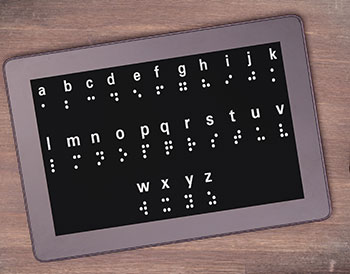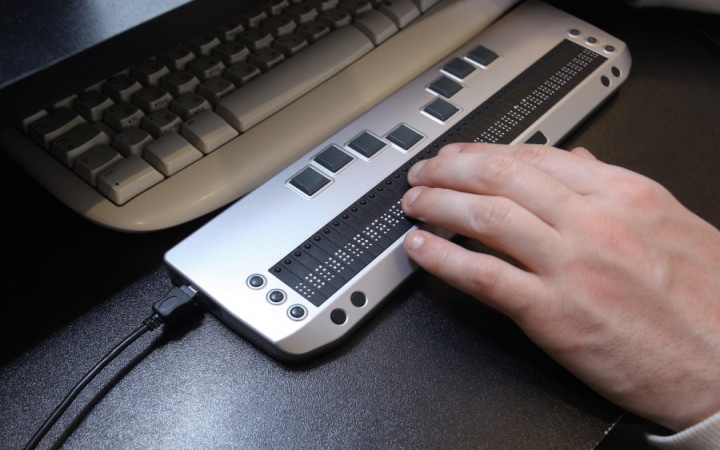Wearable Technology for Low Vision: A Breakthrough in Accessibility
Wiki Article
A Guide to Life-altering Assistive Innovation for the Blind and Aesthetically Damaged
The improvement of assistive technology has ushered in a transformative period for people who are blind or aesthetically impaired, offering tools that improve autonomy and improve everyday experiences. Developments such as clever navigation tools and AI-driven applications are redefining how individuals interact with their environments, while available analysis options and clever home modern technologies assure to more raise the top quality of life.Smart Navigating Equipment
Smart navigating devices are transforming the method individuals who are blind or aesthetically impaired communicate with their atmosphere. These advanced innovations, which incorporate general practitioners, audio feedback, and haptic signals, supply users with crucial info concerning their environments, boosting their self-reliance and flexibility.
One prominent example is making use of clever walking canes furnished with sensors that detect obstacles and offer real-time feedback with resonances or audio signs. These tools enable users to browse complex settings, such as active roads or crowded public areas, with enhanced self-confidence. Additionally, wearable gadgets, such as wise glasses, are being developed to assist in identifying faces, reviewing text, and identifying things, additionally augmenting the individual's spatial understanding.
Additionally, clever navigating tools are increasingly including man-made knowledge to examine data and adjust to individuals' preferences. This personalized strategy not only boosts navigation efficiency yet likewise fosters a feeling of empowerment among customers. As innovation proceeds to advancement, the capacity for smart navigating tools to produce a more comprehensive and accessible globe for people who are aesthetically impaired or blind stays appealing, ultimately reshaping their day-to-day experiences and interactions.
Ingenious Mobile Applications
Mobile applications are becoming effective tools for aiding people who are visually damaged or blind, using a variety of performances that boost daily living. These applications harness advanced innovation to help with everyday jobs, boost availability, and advertise independence.One category of cutting-edge mobile applications concentrates on aesthetic recognition. Applications like Be My Eyes connect customers with sighted volunteers through video clip phone calls, making it possible for real-time help for tasks such as reviewing tags or navigating unfamiliar settings. Applications like Seeing AI utilize synthetic intelligence to describe surroundings, read text, and identify objects, supplying individuals with vital details at their fingertips.
An additional substantial location is navigating and positioning. Apps such as Aira and Close-by Explorer offer audio support, assisting individuals navigate urban rooms easily. They supply customized support, permitting an extra positive exploration of the setting.
In addition, wellness and health apps satisfy specific demands, such as medicine administration and fitness monitoring. These applications intend to promote a holistic approach to health, making sure that individuals can maintain their wellness separately.
Wearable Assistive Gadgets
Wearable assistive devices stand for a considerable advancement in modern technology created to support individuals that are blind or aesthetically impaired. These tools improve wheelchair and self-reliance by providing real-time responses about the surrounding setting. Among one of the most noteworthy wearable modern technologies are smart glasses outfitted with cameras and sensing units, which can determine barriers and relay important details with sound cues.
An additional innovative alternative includes wrist-worn tools that utilize ultrasonic waves to identify obstacles and supply navigational support. These devices usually include customizable setups, allowing customers to tailor the notifies to their particular needs.
The combination of synthetic knowledge in wearable assistive technology is additionally notable, as it consistently enhances the accuracy and responsiveness of these devices. Generally, wearable assistive devices are transforming the lives of the blind and visually impaired, promoting better autonomy and improving quality of life via innovative remedies.
Available Checking Out Solutions
Accessible reading options play an essential duty low vision aids in enabling individuals that are blind or aesthetically impaired to involve with message across different layouts. These solutions include a series of devices and technologies developed to improve analysis experiences, from typical print materials to digital content.One famous solution is Optical Character Recognition (OCR) innovation, which transforms published message right into electronic layout, allowing users to pay attention to or review the web content using screen readers. Additionally, specialized e-readers geared up with text-to-speech abilities provide adjustable analysis experiences, allowing users to adjust font sizes and background colors for improved visibility.
Another effective approach is braille display screens, which give tactile responses by transforming electronic message into braille. This enables individuals to go through touch, cultivating better freedom and accessibility to literature. Mobile applications developed for checking out scanned books or files can encourage customers with instantaneous access to a huge collection of products (Wearable technology for low vision).

Smart Home Technologies
Smart home innovations have actually reinvented the method individuals who are blind or visually impaired connect with their living settings, boosting both freedom and security. These innovative services utilize automation and connectivity to create an accessible living room customized to the demands of individuals.Smart speakers and voice-activated assistants provide hands-free control over numerous tools, enabling users to readjust temperature, protection, and lights procedures with straightforward voice commands. This functionality decreases reliance on sighted aid and cultivates a sense of autonomy. Additionally, smart lights systems can be personalized to deliver auditory comments or tactile hints, making it possible for people to navigate their homes a lot more efficiently.
Furthermore, safety and security systems furnished with wise video cameras and sensors can send out real-time informs to users, boosting personal safety and security without necessitating visual verification. Automated door locks use peace of mind, allowing individuals to protect their homes effortlessly.
Integrating smart home modern technologies not only boosts daily living but likewise urges social interaction with attached devices - Braille displays and notetakers. With ongoing improvements in assistive innovation, the future shows up appealing, as even more solutions will emerge to additional equip people that are visually impaired or blind, guaranteeing a much more comprehensive and independent way of living
Verdict
To conclude, the improvements in assistive modern technology for the visually damaged and blind stand for a substantial leap towards improving self-reliance and lifestyle. Smart navigation tools, ingenious mobile applications, wearable gadgets, easily accessible reading solutions, and clever home innovations collectively cultivate a webpage comprehensive atmosphere. This integration of modern technology not only improves mobility and day-to-day living however also encourages individuals to involve completely with their surroundings, advertising greater freedom and involvement in culture.
Advancements such as smart navigating devices and AI-driven why not try these out applications are redefining exactly how individuals engage with their environments, while obtainable reading services and wise home innovations assure to more elevate the quality of life. As modern technology continues to breakthrough, the possibility for wise navigating tools to produce a more easily accessible and comprehensive world for individuals that are blind or visually impaired stays encouraging, ultimately improving their day-to-day experiences and interactions.
Wearable assistive gadgets stand for a significant improvement in innovation made to sustain people who are blind or aesthetically damaged. Among the most remarkable wearable technologies are wise glasses geared up with electronic cameras and sensors, which can recognize obstacles and relay important info via sound cues.
Smart navigation tools, innovative mobile applications, wearable tools, available analysis solutions, and wise home innovations jointly promote a comprehensive setting.
Report this wiki page